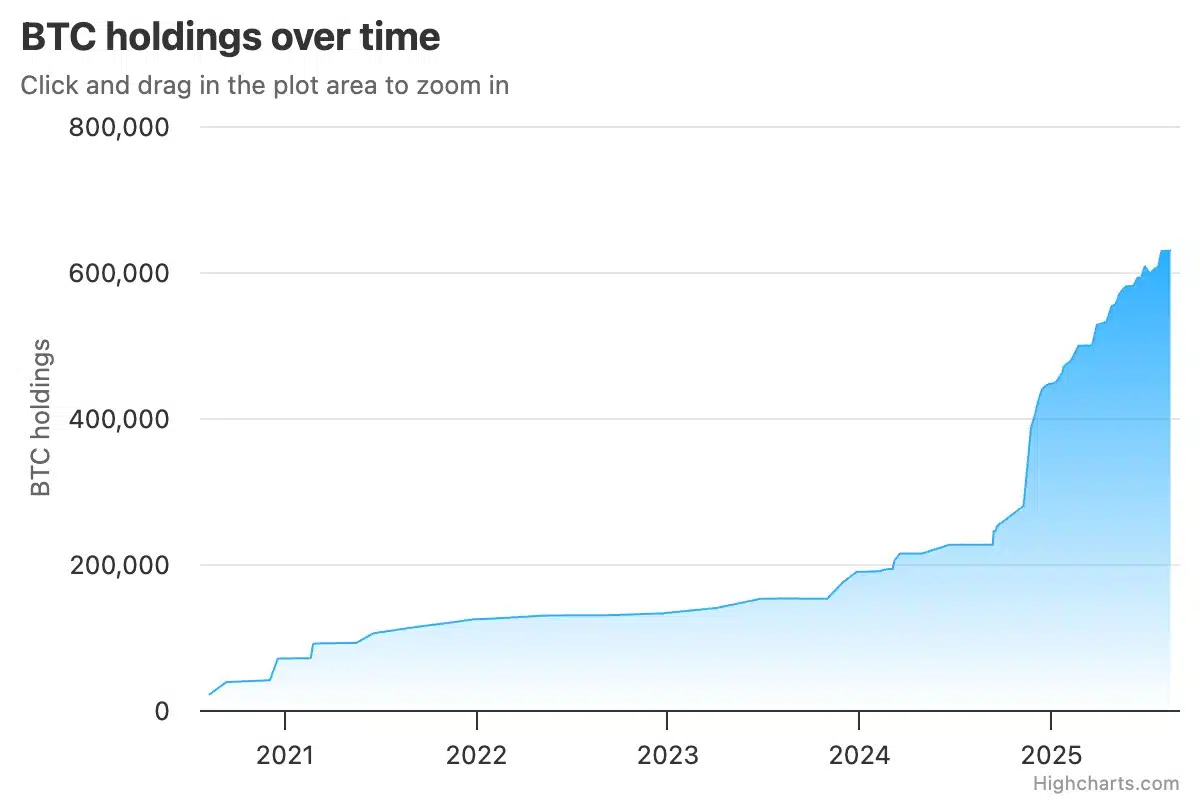In the world of corporate crypto, two names stand out, and they couldn’t be more different. One company is a fanatic, leveraging everything to buy more Bitcoin. The other dabbled, got spooked, and now sits on the sidelines.
The last quarter of the year is about to put both playbooks to the ultimate test, and the results could sway how other companies decide to dip their toes in the water.
MicroStrategy – The all-in Bitcoin whale
Michael Saylor’s MicroStrategy isn’t just a company that owns Bitcoin; it is a Bitcoin company now. His obsession has made it the biggest corporate whale out there. The firm’s playbook is simple – Buy Bitcoin and never, ever sell. By its last count in August 2025, the stash had ballooned to a mind-boggling 629,376 BTC.

Source: MicroStrategy’s BTC holdings/BitBo
This mountain of crypto wasn’t built with spare cash. MicroStrategy built a money machine, issuing billions in debt and new stock specifically to hoover up more coins, especially when prices dip.
It’s a feedback loop – they buy BTC, the price action helps their stock, and they use their pricier stock to raise more money to buy more BTC.
Tesla – Once bitten, twice shy HODLer
Then, there’s Tesla, whose Bitcoin adventure has been as erratic as an Elon Musk tweet. The carmaker cannonballed into the market in 2021 with a $1.5 billion buy, briefly let customers pay with it. However, it then yanked the plug, blaming a guilty conscience over mining’s energy use. That one move sent the market into a tailspin.
Unlike Saylor’s diamond-hand approach, Tesla cashed out big, selling off about 75% of its stack for nearly a billion dollars in mid-2022. Musk said it was about shoring up cash, not a judgment on Bitcoin itself.


Source: Bitcoin Treasuries
Now, they just sit on what’s left – An estimated 11,509 BTC.
An accounting rule that changes everything
Everything changed in Q4 last year thanks to a monster new accounting rule. Before, the bean counters had a weird system – Companies could report when their crypto lost value, but never when it gained value until they sold. It was all pain, no paper gain.
Since 15 December 2024, that’s over. The Financial Accounting Standards Board’s new rule (ASU 2023-08) forces companies to mark their crypto holdings to their real, current market price every quarter.
Those swings, up or down, will flow directly into the net income line on their earnings reports. A Bitcoin rally could make their profits look gigantic. A crash could make them look disastrous, even if they didn’t sell a single coin.
How does Wall Street see these stocks?
This new accounting reality will mess with investor heads, but the market already treats these two stocks very differently.
- MicroStrategy (MSTR) – This stock is basically a Bitcoin ETF with a CEO. Its price is welded to Bitcoin’s, moving in lockstep but with way more volatility. If you want to bet on Bitcoin without opening a crypto account, you buy MSTR. That leverage cuts both ways, though; when Bitcoin sneezes, MSTR gets the flu.
- Tesla (TSLA) – This is a whole other story. The initial Bitcoin buy briefly tied the stock to crypto, but not anymore. Investors care about car deliveries, battery tech, and AI promises. Musk can still jolt the crypto market with a tweet, but his company’s stock now marches to the beat of its own drum.
Economic crosscurrents and crypto wildcards
Of course, none of this is happening in a bubble. The wider economy will have its say in Q4. All eyes are on the Federal Reserve. If they start cutting interest rates, investors might feel brave enough to pour money into riskier things like Bitcoin. If they stay hawkish to fight inflation, that could kill the mood. The spiraling U.S. budget deficit is also lurking in the background, pushing some to see Bitcoin as a safe harbor from a devaluing dollar.
Inside the crypto world itself, the big drama is the SEC. The agency has a stack of applications for new crypto ETFs—for coins like Solana, XRP, and Litecoin—with deadlines hitting in October. A wave of approvals could open the floodgates for big money. A string of rejections could send the market packing.
So, the stage is set for a fascinating final quarter.
You have MicroStrategy, the loud and proud accumulator, doubling down again and again.
And, you have Tesla, the quiet giant, sitting on its stack with an unreadable poker face.
Their clashing philosophies show just how messy and uncertain the corporate path into digital money really is.
